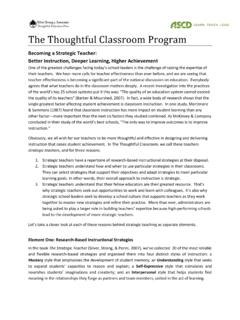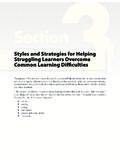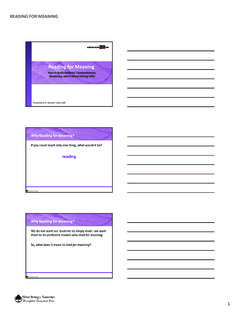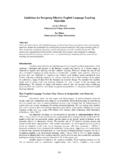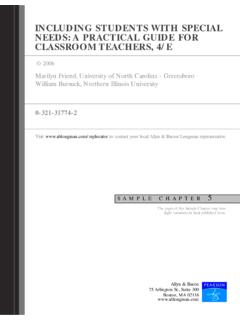Transcription of for the Thoughtful Classroom Teacher Effectiveness …
1 Silver Strong & Associates | 3 Tice Road, Suite 2 Franklin Lakes, NJ 07417 | | 800-962-4432 Guidance on Section 1249(3) of Michigan Public Act 173 (2015) for the Thoughtful Classroom Teacher Effectiveness Framework MAY 2016 2016 Silver Strong & Associates | 1 Michigan Public Act 173, Section 1249(3) State of Michigan Act No. 173 Public Acts of 2015 (Effective Date: November 5, 2015) From Section 1249: (3) Beginning with the 2016-2017 school year, a school district, intermediate school district, or public school academy shall post on its public website all of the following information about the evaluation tool or tools it uses for its performance evaluation system for teachers: (a) The research base for the evaluation framework, instrument, and process or, if the school district, intermediate school district, or public school academy adapts or modifies an evaluation tool from the list under subsection (5), the research base for the listed evaluation tool and an assurance that the adaptations or modifications do not compromise the validity of that research base.
2 (b) The identity and qualifications of the author or authors or, if the school district, intermediate school district, or public school academy adapts or modifies an evaluation tool from the list under subsection (5), the identity and qualifications of a person with expertise in Teacher evaluations who has reviewed the adapted or modified evaluation tool. (c) Either evidence of reliability, validity, and efficacy or a plan for developing that evidence or, if the school district, intermediate school district, or public school academy adapts or modifies an evaluation tool from the list under subsection (5), an assurance that the adaptations or modifications do not compromise the reliability, validity, or efficacy of the evaluation tool or the evaluation process.
3 (d) The evaluation frameworks and rubrics with detailed descriptors for each performance level on key summative indicators. (e) A description of the processes for conducting Classroom observations, collecting evidence, conducting evaluation conferences, developing performance ratings, and developing performance improvement plans. (f) A description of the plan for providing evaluators and observers with training. For more information on the development of this legislation and the full text of Public Act 173 of 2015, please visit the following page on the Michigan Legislature website: 2016 Silver Strong & Associates | 2 A | Research Base The Thoughtful Classroom Teacher Effectiveness Framework (TCTEF) is based on five distinct lines of research: 1.
4 Instructional Design & Delivery At the heart of the TCTEF is an instructional design model synthesizing the best research on how to design and deliver lessons and units that promote student learning, including Madeline Hunter's classic "Elements of Lesson Design" (1984), Understanding by Design (Wiggins & McTighe, 2005), and The Art and Science of Teaching (Marzano, 2007). By synthesizing this research, we have identified five universal "episodes" that all well-designed instructional sequences include: Preparing Students for New Learning Presenting New Learning Deepening and Reinforcing Learning Applying Learning Reflecting On and Celebrating Learning For each of the Five Episodes (Dimensions 5-9), the TCTEF outlines six to eight observable, research-based teaching practices.
5 By aligning these practices to particular instructional episodes, we help ensure that administrators are looking for the right things at the right time and are "on the same page" as the Teacher being observed. 2. Research-Based Instructional Practices These practices are drawn from a wide body of research identifying those practices that are proven to raise student achievement, including the meta-analytic studies Classroom Instruction that Works (Marzano, Pickering, & Pollock, 2001) and The Art and Science of Teaching (Marzano, 2007), and our own research-based texts, The Strategic Teacher (Silver, Strong, & Perini, 2007) and Tools for Thoughtful Assessment (Boutz, Silver, Jackson, & Perini, 2012). From these and other resources, we have identified over thirty specific and observable teaching practices that are backed by a strong and reliable research base.
6 3. Formative Assessment Instruction and assessment go hand in hand, and research clearly demonstrates that when instruction is informed by regular formative assessment, student learning in-creases dramatically (Black & William, 1998; Ehrenberg, Brewer, Gamoran, & Willms, 2001; Black, 2003; Rodriguez, 2004). Built into the TCTEF are indicators designed around the research findings and Classroom recommendations of leading experts on formative assessment (Stiggins, Arter, Chappuis, & Chappuis, 2006; Chappuis, 2009). As with the indicators defining good instructional practices, the indicators defining good assessment practices are linked to specific instructional episodes. A | Research Base 2016 Silver Strong & Associates | 3 4. Teacher Effectiveness The impetus for developing the TCTEF came out of our work with dozens of schools and districts that were using the preeminent Teacher Effectiveness models, including Charlotte Danielson's Enhancing Professional Practice (2007), Robert Marzano's The Art and Science of Teaching (2007), and Marzano, Frontier, and Livingston's Effective Supervision: Supporting the Art and Science of Teaching (2011).
7 These schools were requesting help in applying and adapting these models, in providing teachers with the training in research-based strategies they needed to improve their practice, and in training administrators to conduct more meaningful and productive observations. In working with these schools over time, we became deeply familiar with Danielson's and Marzano's frameworks, both in terms of the research behind them and in terms of how schools were using them to improve teaching and learning. A key development that emerged from this work was the identification of the Four Cornerstones of an Effective Classroom (Dimensions 1-4 of the TCTEF). Research on Teacher Effectiveness shows that a successful Classroom is much more than a well-managed Classroom . By conducting a deep analysis of preeminent Teacher Effectiveness frameworks and standards (CCSSO, 2011; Danielson, 2013; Marzano, 2013; Stronge, 2010) and working with hundreds of teachers to convert the research into a simple and practical Classroom model, we have found that all successful classrooms rest on Four Cornerstones: Organization, Rules, and Procedures Positive Relationships Engagement and Enjoyment A Culture of Thinking and Learning These Four Cornerstones are the non-negotiables of a truly successful learning environment those universal elements that we find in all highly effective classrooms.
8 For each of the Four Cornerstones, the TCTEF outlines six to eight observable, research-based teaching practices. 5. Feedback from the Field Research can only take us so far. At Silver Strong & Associates, we have been working with hundreds of schools over the last 40 years to improve Teacher Effectiveness . So, while all the indicators in our TCTEF are research-based, we also knew that the indicators had to be clear and usable for educators. Thus, as we developed our indicators, we asked over 250 teachers and administrators to review the indicators, test their validity through trial observations, and help us refine and streamline the TCTEF so that it would meet the needs of teachers and administrators. 2016 Silver Strong & Associates | 4 B | Qualifications The Thoughtful Classroom Teacher Effectiveness Framework is a comprehensive system for observing, evaluating, and refining Classroom practice.
9 It synthesizes a wide body of research on instructional design and Teacher Effectiveness , as well as insight from over 250 teachers and administrators from around the country. The ultimate goal of the TCTEF is to create a common language for talking about high quality teaching and how Classroom practice can be improved. LEAD DEVELOPER Harvey F. Silver, EdD, is the cofounder and president of Silver Strong & Associates and Thoughtful Education Press. He has over four decades of experience as an educator, presenter, coach, and consultant. Harvey is a best-selling author and has conducted thousands of workshops for schools, districts, and state education organizations throughout the United States. He is a dynamic presenter who speaks regularly at regional, national, and international conferences.
10 As lead developer of the Thoughtful Classroom Teacher Effectiveness Framework, Harvey worked with over 250 educators in the field to learn about their concerns regarding Teacher evaluation and to develop a Thoughtful approach to observing, evaluating, and refining Classroom practice. CO-DEVELOPER Matthew J. Perini, MA, serves as Senior Director of Content Development for Silver Strong & Associates and Thoughtful Education Press and oversees all aspects of content development including publishing, workshop training designs, and marketing. An accomplished writer and editor with over a decade of experience in educational publishing, Matt has co-authored a number of recent best-sellers in education. Serving as co-developer, Matt aligned the TCTEF to the significant research and standards on Teacher Effectiveness and created The Thoughtful Classroom Teacher Effectiveness Framework Resource Guide (2012) that supports training and implementation.
